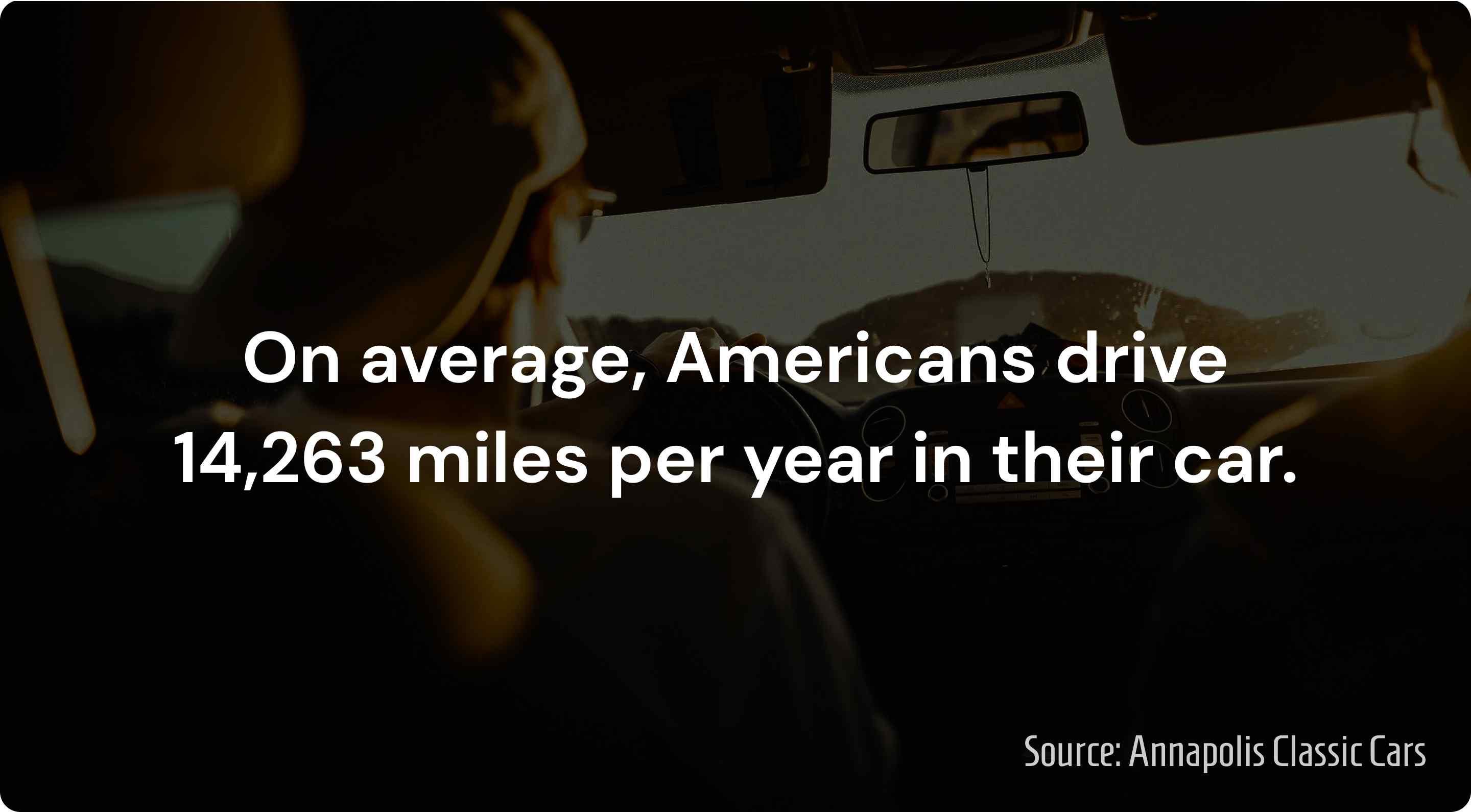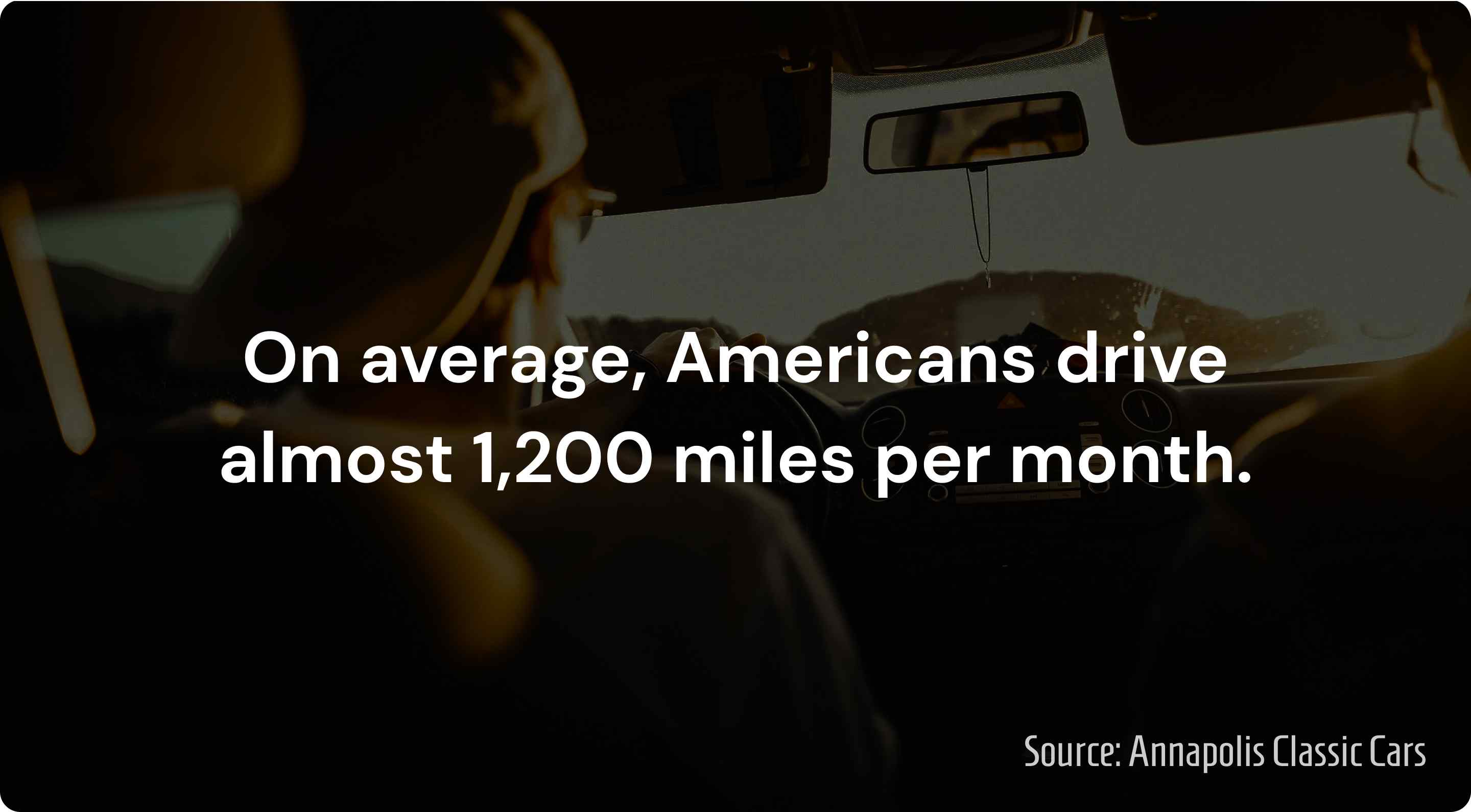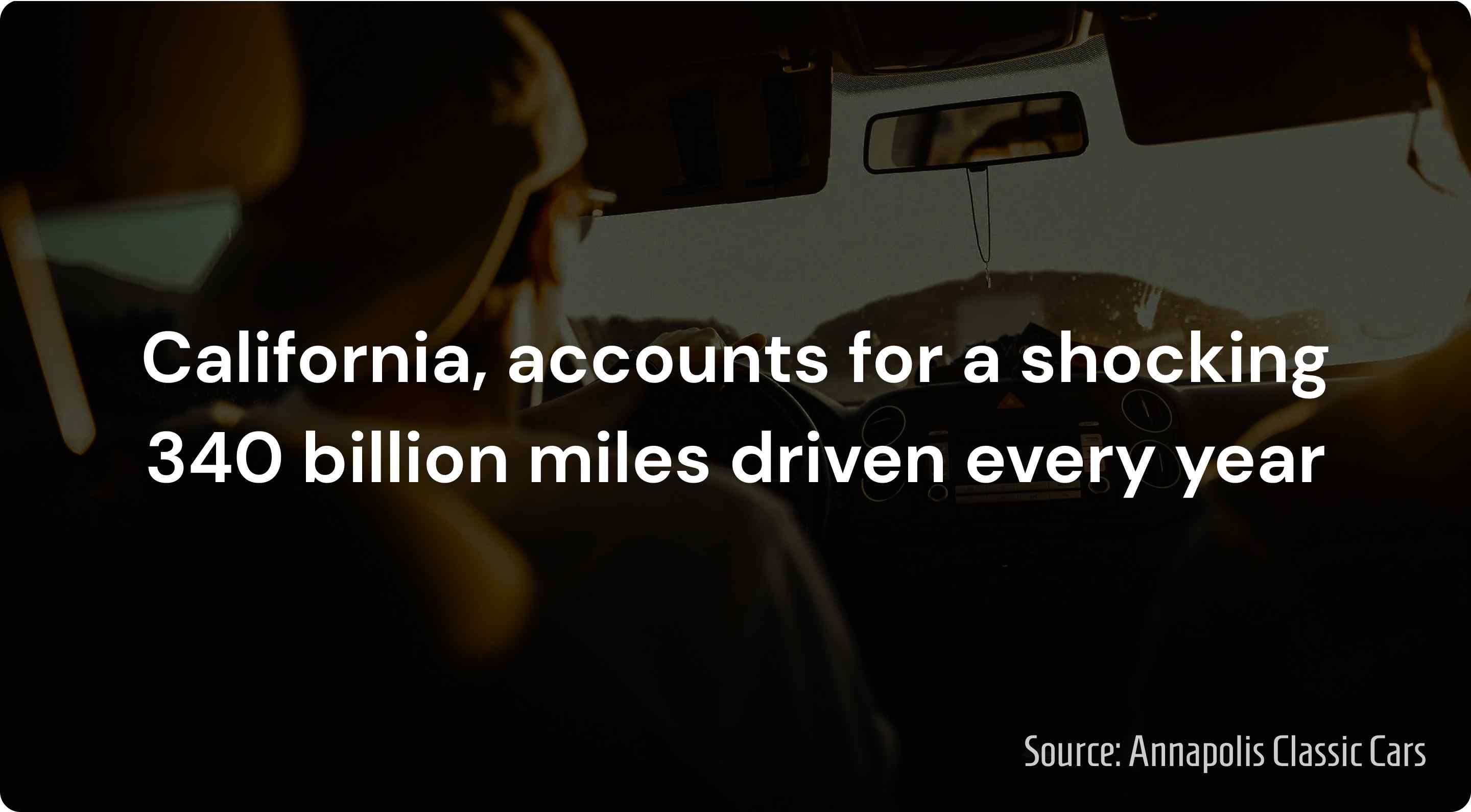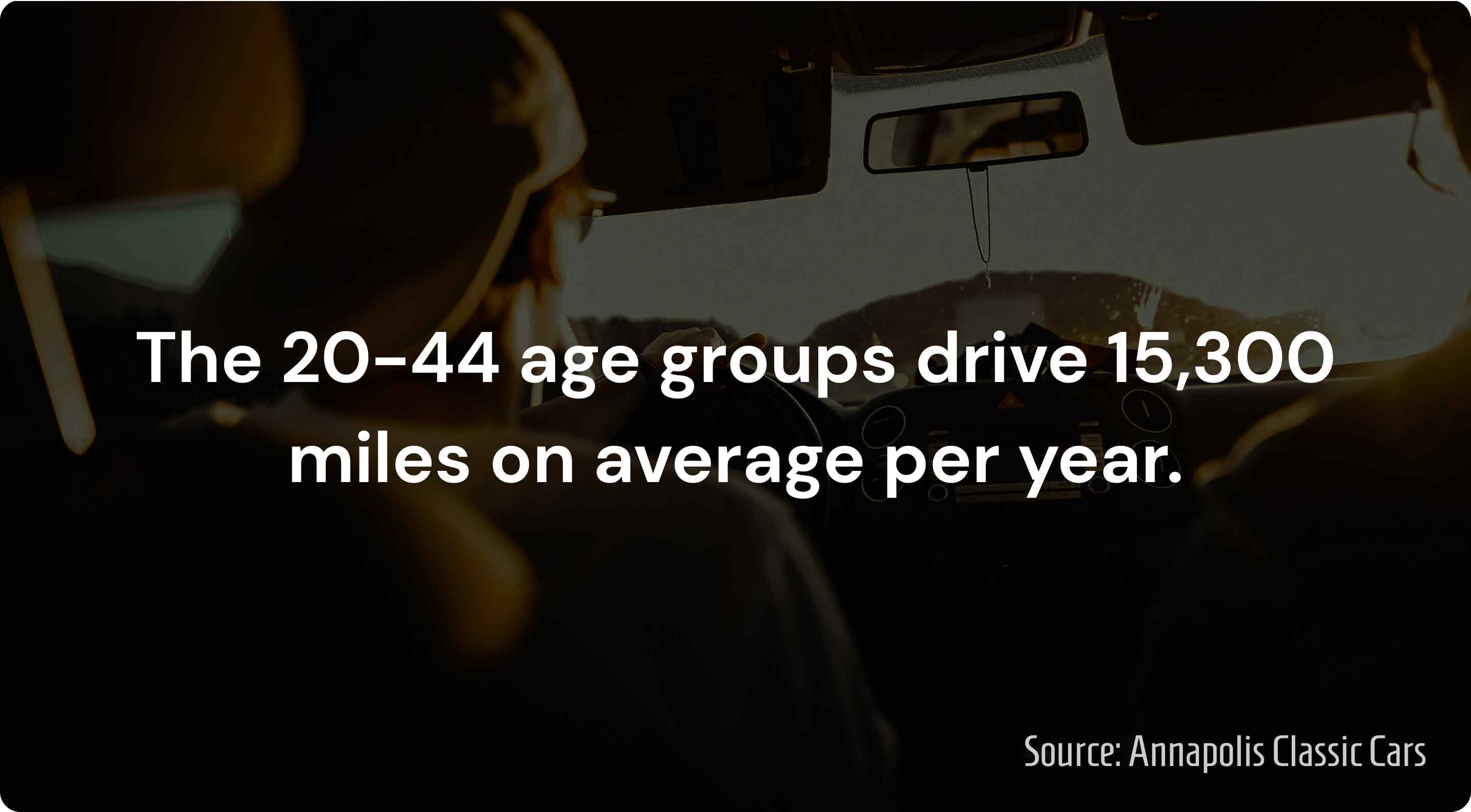Average Miles Driven Per Year In The U.S. (Statistics)
On average, Americans drive 14,263 miles per year according to the Federal Highway Administration.
Keep reading to find new stats, facts, and trends related to:
- Average miles driven per year on a car
- Average miles driven per month
- Average miles driven per day
- Average miles driven per year for work
- Average miles driven by state
- A whole lot more
Keep reading!
Key Statistics & Facts:
Using data from the Federal Highway Administration, we analyzed American driving trends and found a handful of important data:
- On average, Americans drive 14,263 miles per year in their car, which is an average of almost 1,200 miles per month.
- As a collective, Americans drive 3.2 trillion miles per year, enough to take almost 5,000 trips to the moon and back.
- California comes in at the most total miles driven per year (340 billion).
- Wyoming has the highest per capita mileage at 24,000 each year.
- Young drivers between the age of 16 and 19 and adults over 65 drive the least out of all the age groups.
- On average, men drive around 6,000 miles per year more than women, and after retirement drivers post around 30% fewer miles per year.
- During COVID-19, vehicle travel decreased by as much as 60% in April 2020 during the initial lockdowns.
- This year, Americans will spend twice as much money on gas every year as they did in 1950.
- Since 1980, average travel per gallon of fuel only increased to 18 miles, up from 13 miles.
- Drivers can save up to 32% on their car insurance simply by reducing their annual mileage from 15,000 to 7,500.
Keep reading to find more data on how much Americans drive each year. Read on to find all of our findings.
Average Miles Driven Per Year
The amount of miles Americans drive each year is on the rise ever since the federal government founded the Interstate Highway System in the 1950s.
And in the past 40 years, the number of miles Americans collectively drive has grown from 1.5 trillion to a whopping 3.2 trillion miles, which is more than twice as much driving with a population only 1.5 times as large.
On average, Americans drive 14,263 miles per year in their car. And as a collective, Americans drive 3.2 trillion miles per year, enough to take almost 5,000 trips to the moon and back.

Average # Of Miles Driven Per Month
On average, Americans drive almost 1,200 miles per month.

Average Miles Driven Per Day
On average, Americans drive around 39 miles per day.

Average # Of Miles Driven Per Year By State
The number of miles Americans drive depends a lot on the state where they live. For example, the very populous state, California, accounts for a shocking 340 billion miles driven every year, which is more than any other state.

The average driver in California covers 12,500 miles every year, less than the nationwide average of over 14,000. Surprisingly, Oklahoma collectively posts only 44 billion miles each year, which is 85% less than California.

However, each driver averages a higher number of miles driven every year of 17,700 which is much more than the average American as well as Californians.
There are a variety of factors that account for the large differences between driving habits throughout the U.S., including density, population, and fuel costs.
We’ve created a table with the most up-to-date data from the Federal highway Administration which shows how many miles each state drives in total and per driver.
| State | Average Miles Per Driver |
| Alabama | 17,817 |
| Alaska | 11,111 |
| Arizona | 13,090 |
| Arkansas | 17,224 |
| California | 12,524 |
| Colorado | 12,899 |
| Connecticut | 12,117 |
| Delaware | 12,609 |
| District of Columbia | 7,013 |
| Florida | 14,557 |
| Georgia | 18,334 |
| Hawaii | 11,688 |
| Idaho | 14,417 |
| Illinois | 12,581 |
| Indiana | 18,024 |
| Iowa | 14,745 |
| Kansas | 14,781 |
| Kentucky | 16,305 |
| Louisiana | 14,951 |
| Maine | 14,215 |
| Maryland | 13,490 |
| Massachusetts | 13,109 |
| Michigan | 14,307 |
| Minnesota | 17,909 |
| Mississippi | 19,966 |
| Missouri | 18,521 |
| Montana | 15,880 |
| Nebraska | 14,846 |
| Nevada | 14,016 |
| New Hampshire | 11,570 |
| New Jersey | 12,263 |
| New Mexico | 19,157 |
| New York | 10,167 |
| North Carolina | 16,073 |
| North Dakota | 17,671 |
| Ohio | 14,278 |
| Oklahoma | 17,699 |
| Oregon | 12,218 |
| Pennsylvania | 11,445 |
| Rhode Island | 9,961 |
| South Carolina | 14,941 |
| South Dakota | 15,541 |
| Tennessee | 15,287 |
| Texas | 16,172 |
| Utah | 15,516 |
| Vermont | 13,004 |
| Virginia | 14,509 |
| Washington | 10,949 |
| West Virginia | 16,876 |
| Wisconsin | 15,442 |
| Wyoming | 24,069 |
States Where Americans Drive The Most
The places where Americans drive the most on average include five states from the South and the West. Check them out below along with their average miles driven per year:
- Wyoming: 24,069 average miles driven per year
- Mississippi: 19,966 average miles driven per year
- New Mexico: 19,157 average miles driven per year
- Missouri: 18,521 average miles driven per year
- Georgia: 18,334 average miles driven per year

Because the above states are usually more rural and have less population density than other states, they tend to have fewer options for other methods of transportation, therefore making driving a more convenient method of transportation.
States Where Americans Drive The Least
The states with the lowest number of average miles driven per year include states from the broader Pacific Northwest and the East. Below you’ll see the five states that drive the least number of miles as well as their average miles driven per year:
- District of Columbia: 7,013 average miles per year
- Rhode Island: 9,961 average miles per year
- New York: 10,167 average miles per year
- Washington: 10,949 average miles per year
- Alaska: 11,111 average miles per year

Unsurprisingly, the majority of the states with the lowest average miles driven every year include some of the best public transportation systems in the country.
Being the place that Americans drive the least, Washington D.C. is home to one of the biggest public transit systems in the U.S. with 25 transit routes that are less than half a mile from an average neighborhood block.
Often, public transportation is less pricey and a more efficient way to travel than by car in these 5 states, so it’s not surprising that the average number of miles driven is usually lower. Also, as mentioned earlier, fuel costs can also influence whether people drive less on average.
Interestingly, both Alaska and Washington are among the top 10 states with the most expensive prices for regular gas.
How Demographics Affect Average Miles Driven Every Year
Average Annual Miles Per Driver By Age Group
| Age | Male | Female | Total |
|---|---|---|---|
| 16-19 | 8,206 | 6,873 | 7,624 |
| 20-34 | 17,976 | 12,004 | 15,098 |
| 35-54 | 18,858 | 11,464 | 15,291 |
| 55-64 | 15,859 | 7,780 | 11,972 |
| 65+ | 10,304 | 4,785 | 7,646 |
| Average | 16,550 | 10,142 | 13,476 |
According to the most recent available data from the FHWA, noteworthy differences in driving behaviors exist among groups who vary by gender and age.
Gender
Data we analyzed reveals that men drive more miles on average than women. The driving habits between men and women vary in a variety of ways when both age and gender are taken into account. Here are some:
- Across all age groups, men drive more miles than women. Specifically though, this difference is more noticeable in working-age adults, since men drive on average 6,000 miles more every year than women.
- Women over 65 drive the least, just 4,700 miles per year. Interestingly, middle-aged men (ages 35-54) drive the most at 18,800 miles each year.
- People drive more each year until retirement, and then the number of miles per year falls by 30%, on average.

Age
Unsurprisingly, age is a large factor which tends to influence average driving trends. Older, retired adults usually don’t have a commute to work, and high school students might have alternate ways of commuting.
Therefore, the data we analyzed showed us that working-age adults who most likely have to commute to their jobs drive the most miles on average.

- Young drivers between the age of 16 and 19 and adults over 65 drive the least out of all the age groups. Both of these age demographics drive a similar amount, on average, approximately 7,600 miles every year.
- The 20-44 age groups drive 15,300 miles on average per year, which shows that working-age adults drive the most out of all age groups.

What Do Insurance Companies Consider Low Mileage?
Insurance companies typically consider driving 10,000 miles per year or less to be low mileage, despite Americans driving 14,263 miles per year, on average. Remember to check with your insurer to find out what mileage bracket you fall under in order to get a discount on your insurance rates.

You should be able to find the best discounts with most companies if you drive less than 7,000 miles a year. The amount of miles Americans drive every year depends a lot on age and gender.
However, the COVID-19 pandemic has influenced driving patterns for Americans collectively, with the average miles driven decreasing ever since.
How Does Annual Mileage Affect Car Insurance?
The amount of miles that you drive annually will influence your car insurance rates. For example, if you’re a high mileage driver, your insurance rates typically go up because there’s a greater risk of you getting into an accident.
However, if you’re a low mileage driver, you might be able to actually save money on your car insurance.
COVID-19’s Impact On Driving Trends
The Average Number Of Miles Drive Per Year Decreased During The Pandemic
Many roads across the U.S. were virtually abandoned after the country was in quarantine during lockdown in March 2020. With millions of Americans working from home or unfortunately unemployed, daily commutes became a much less common event.
Simultaneously, most public places were closed and that meant Americans were mostly confined to just their homes. This led to a large reduction in the number of miles driven across the U.S.
The Bureau of Transportation Statistics developed a metric for estimating changes in vehicle travel during the pandemic. They established it by calculating the average trip count, average trip distance, distance traveled, and trip duration to create an observed value which they compared against the average typical value for that day of the week.
After the team who developed the chart established a baseline for vehicle travel based on the period prior to the start of COVID-19 lockdowns in the U.S. in March 2020, the BTS calculated reductions in the countrywide automobile travel for the rest of the calendar year.
Traffic Accidents Are On The Rise Despite Americans Driving Less
Over the first year of the pandemic in America, vehicle miles traveled decreased by 430 billion miles, or around 13%. Despite this reduction, fatal accident rates increased from 1.11 per 100 miles traveled in 2019 to 1.37 per 100 million miles traveled in 2020.
This is a 7% increase in fatalities, and as the nation started to open back up last year, the number of miles Americans traveled increased by almost 8%. This number is still lower than pre-pandemic numbers.
Unsurprisingly, with more drivers back on the road, the number of fatalities has also increased by around 10% compared to the previous year.